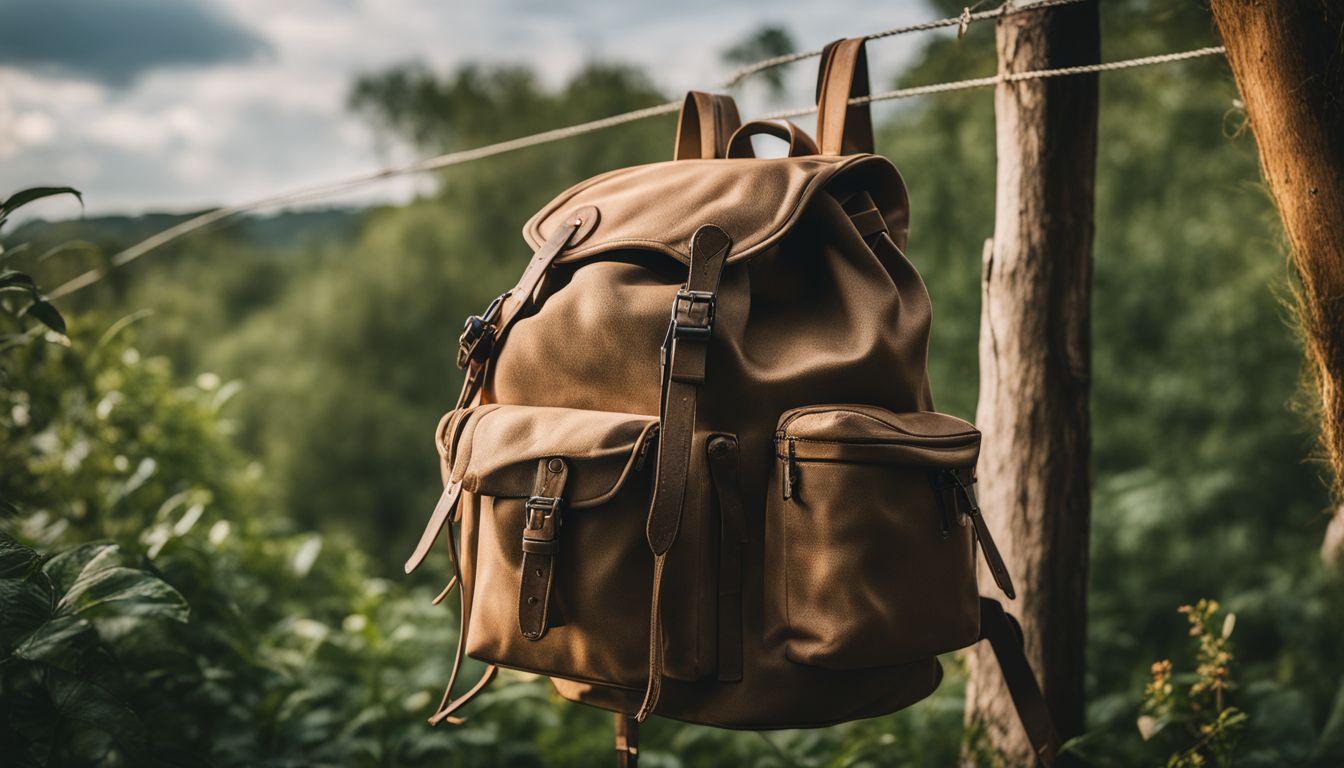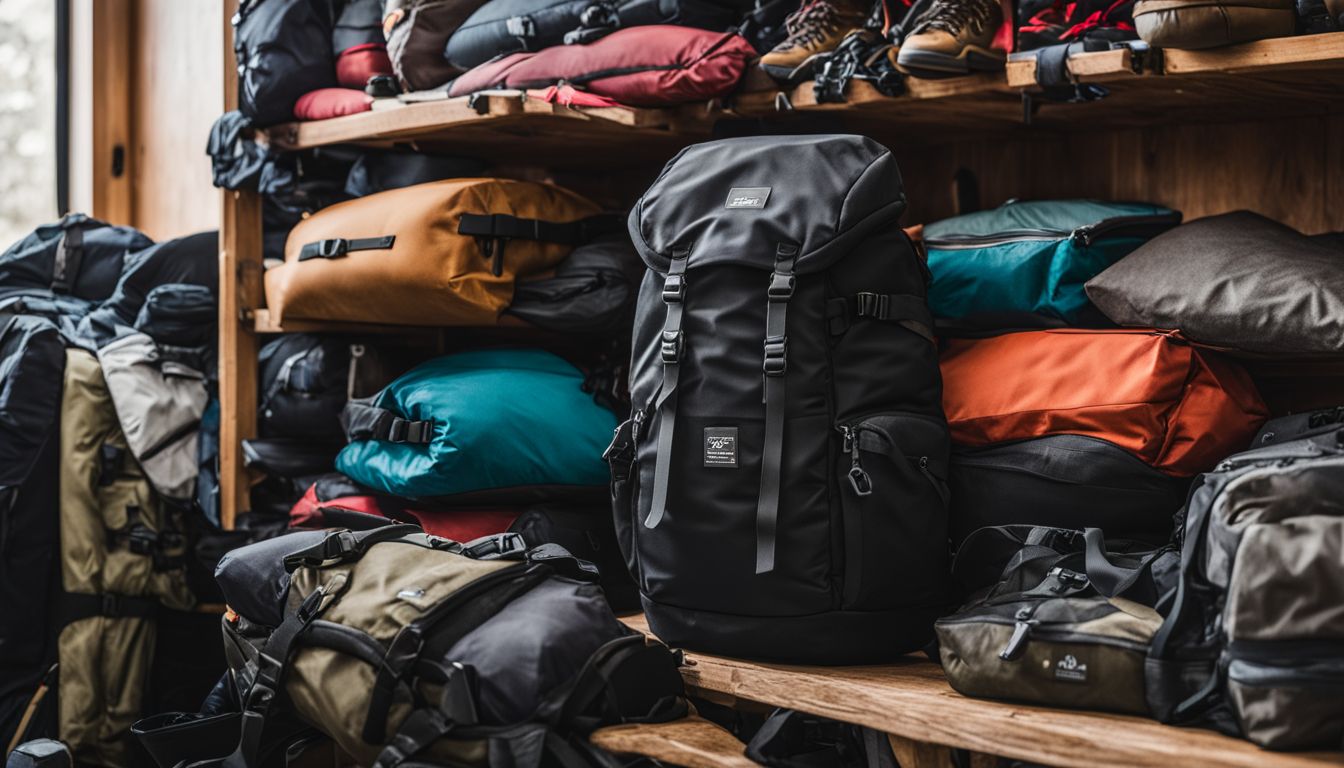Caring for your rucksack properly does more than just keep it looking good; it’s a step towards a healthier planet. Many of us don’t realize that each time we replace a worn-out bag, we’re adding to the pile of waste harming our environment.
As an expert in sustainable living with years spent studying and applying eco-friendly practices, I’ve seen first-hand how small changes in our routine can make a significant impact.
Adopting sustainable rucksack care practices can extend the life of your backpack while reducing your carbon footprint—a win-win for you and Earth. With simple methods like proper cleaning, storage, and repairs, you’ll discover not only how to maintain your beloved carryall but also contribute positively to environmental conservation efforts.
Let’s dive into making sustainability part of every journey—your rucksack will thank you!
Key Takeaways
- Clean your rucksack regularly using mild detergent and water, focusing on heavily soiled areas to maintain its condition and extend its lifespan.
- Repair any tears or damages promptly with a heavy – duty needle and thread, ensuring the rucksack is completely dry before storing it in a cool, dry place away from direct sunlight to prevent unnecessary strain on the straps and seams.
- Consider using natural cleaning products like vinegar, baking soda, and lemon juice for eco-friendly rucksack care, as well as upcycling or donating old rucksacks to reduce waste and preserve natural resources.
How to Clean a Rucksack

To clean a rucksack, start by removing any loose dirt or debris with a soft brush. Then, use a mild detergent and warm water to spot clean the fabric, paying extra attention to areas with stains or discoloration.
Avoid using fabric softeners or harsh chemicals that can damage the material. After cleaning, allow the bag to air dry completely before storing it away for future use.
Light Cleaning Techniques
Taking good care of your rucksack keeps it looking great and helps the environment. Light cleaning can be easy and safe for your bag.
- Start with an empty ruck. Make sure all pockets are clear of stuff like papers or food.
- Use a soft brush to gently sweep away any loose dirt on the surface. This will protect the bag’s coating.
- For spot cleans, mix lukewarm water with mild detergent. Dip a makeup brush or soft cloth in the mixture and lightly scrub the spot.
- Focus on areas that get touched a lot, such as handles and straps. These spots can gather more dirt.
- Wipe down the rucksack with a damp cloth to remove any soap. Only use water here so no soap stays on the fabric.
- Let your rucksack air dry completely before using it again. Hang it up in a well-ventilated area away from direct heat.
Deep Cleaning Methods
Deep cleaning your rucksack helps it last longer and stay fresh. Here’s how to do a thorough cleaning without causing any damage:
- Check the care label for instructions specific to your ruck. It’s important to follow these guidelines.
- Take out all items from your rucksack, including those in the pockets. Turn inside out and unzip everything.
- Remove detachable straps and parts if possible before you start cleaning.
- Use a soft brush or cloth to shake off loose dirt from both inside and outside.
- Fill a basin with cool water and add a small amount of mild laundry detergent.
- Submerge only those rucksacks that are safe for this, as some should not be fully soaked in water.
- Gently cleanse the ruck with a sponge or soft brush, paying extra attention to heavily soiled spots.
- For spot cleaning, use a clean cloth with water and gentle cleanser on areas that are dirty.
- Rinse thoroughly by running cool water until all soap is gone from the fabric.
- Never wring out the wet backpack as it can damage the material; instead, press out excess water gently.
- Air dry by hanging in a well – ventilated space away from direct sunlight; never machine dry.
Treating Stains
After your rucksack goes through a deep clean, you might still find some tough spots. Stain treatment is key to making your rucksack look new again. Here are ways to get rid of stubborn stains:
- Spot clean with care. Use a soft brush or cloth and lukewarm water mixed with mild detergent to gently rub the stain.
- Try an enzymatic stain remover for tougher grime. Follow the product directions for the best results.
- Rinse thoroughly after treating the spot. Make sure no soap is left on the fabric.
- Air drying is crucial. Hang your rucksack and let it fully dry before using it again.
- For oily stains, create a paste with baking soda and water. Apply gently, let it sit for a few hours, then brush off.
- Avoid harsh chemicals like chlorine bleach that can damage the fabric.
- Always test a small area first to make sure your cleaner won’t harm the backpack’s material.
How to Repair and Store a Rucksack

Inspect your rucksack for any tears, loose threads, or broken zippers. Use a heavy-duty needle and thread to mend any small tears or holes. For larger damages, consider taking it to a professional for repair. Once repaired, ensure the rucksack is completely dry before storing it in a cool, dry place away from direct sunlight. If possible, store it flat instead of hanging to prevent unnecessary strain on the straps and seams.
Eco-Friendly Rucksack Cleaning Tips
Consider using natural cleaning products, upcycling or donating old rucksacks, and avoiding harsh chemicals for a sustainable approach to caring for your gear. Read on to learn more about eco-friendly rucksack care practices!
Use of Natural Cleaning Products
Natural cleaning products like vinegar, baking soda, and lemon juice are effective alternatives to harsh chemicals. These non-toxic solutions can reduce reliance on traditional cleaners that contain harmful toxins.
By opting for eco-friendly cleaning products, you not only minimize negative effects on the environment but also contribute to improved indoor air quality and reduced health risks.
Using chemical-free cleaning agents benefits both the ecosystem and personal well-being.
Eco-friendly rucksack care involves utilizing natural ingredients in your cleaning regimen. Vinegar, baking soda, and lemon juice offer powerful yet gentle cleansing properties without the use of toxic chemicals.
These natural alternatives effectively clean rucksacks while minimizing harm to the environment and ecosystems.
Upcycling or Donating Old Rucksacks
After ensuring your rucksack is clean and well-maintained, consider upcycling or donating it. Upcycling old rucksacks keeps them out of landfills by creatively transforming them into something new and useful.
For example, excess textiles from old backpacks can be repurposed into unique clothing items or other accessories like bags. Additionally, many brands are giving back by using recycled materials in their production process, planting trees, and helping clean up the environment through sustainable backpack production.
By upcycling or donating your old rucksacks, you contribute to reducing waste and preserving natural resources.
Old rucksacks can also be donated to those in need. Organizations often accept gently used backpacks to distribute to individuals facing financial challenges or environmental disasters.
Avoiding Harsh Chemicals
When it comes to sustainable rucksack care, avoiding harsh chemicals is crucial. Using green cleaning products can help reduce the negative impact on the environment and protect both your health and the durability of your rucksack.
Additionally, steering clear of products containing PFAS chemicals in kids’ backpacks is essential due to their harmful links to environmental and health concerns. Eco-friendly laundry products free from harmful chemicals not only contribute to sustainability but also promote skin and respiratory health.
When caring for eco-leather rucksacks, it’s equally important to avoid alcohol, acetone, or strong cleaning agents that contain harsh chemicals.
Conclusion – Tips for Maintaining a Sustainable Rucksack
In conclusion, maintaining your rucksack sustainably is simple and impactful. By cleaning and repairing it properly, you can extend its life while reducing environmental impact. Remember to use eco-friendly products and methods for a practical and efficient approach.
By doing so, you contribute to sustainability in the fast-paced world of backpack care. Take action today to prolong your rucksack’s lifespan and minimize waste.
FAQs
1. Can I wash my rucksack in a machine?
Yes, you can often machine-wash your canvas backpacks. Use a gentle cycle and zip it up before washing. After washing, line dry your ruck.
2. Are there special tips for pre-cleaning my backpack?
Before you use the washer, remove loose dirt from your backpack with a soft brush. Check care labels to see if it’s safe for machine or hand-washing.
3. Should I dry clean my rucksack?
No, avoid taking your rucksacks to dry cleaners because the chemicals used in dry cleaning can harm some fabrics.
4. What kind of soap should I use when washing my backpack?
Use mild detergents like Persil or Tide if you are handwashing or machine washing on gentle cycle.
5. Is it okay to tumble dry my backpack after washing?
It is better not to tumble-dry as high heat might damage the fabric; always choose to line dry outside instead.

